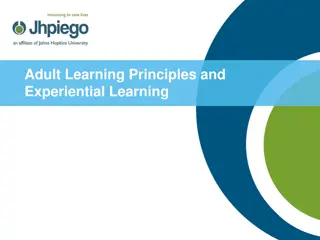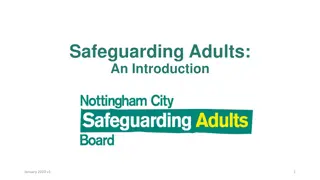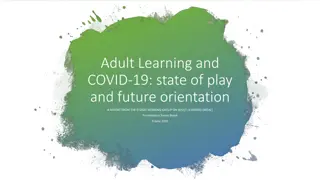Characteristics of Adult Learners: A Guide for Educators
Adult learners are diverse in their backgrounds and responsibilities, necessitating a tailored approach to education. Educators should engage learners in determining their needs, respect their perspectives, and incorporate past experiences. Providing flexibility, positive reinforcement, and problem-centered learning can enhance adult learning experiences. Recognizing adults' self-directed nature and fostering a supportive environment are key to effective adult education.
Download Presentation

Please find below an Image/Link to download the presentation.
The content on the website is provided AS IS for your information and personal use only. It may not be sold, licensed, or shared on other websites without obtaining consent from the author.If you encounter any issues during the download, it is possible that the publisher has removed the file from their server.
You are allowed to download the files provided on this website for personal or commercial use, subject to the condition that they are used lawfully. All files are the property of their respective owners.
The content on the website is provided AS IS for your information and personal use only. It may not be sold, licensed, or shared on other websites without obtaining consent from the author.
E N D
Presentation Transcript
Characteristics of Adult Learners Adults are heterogeneous (diverse) learners Involve learners in determining their own learning needs and how to meet them. Expect and encourage differences of opinion and meaning. Respect the unique perspective and background of each learner. Try to get to know the orientees as individuals. Adults have multiple responsibilities Recognize that other responsibilities may interfere with readiness, participation, or learning achievement (family, social, financial, transport, child care issues). Provide flexibility in scheduling, teaching strategies, and options for learning to make education convenient for adults. Provide opportunities for adults to participate actively in all phases of the educational experience. Start and stop learning activities on time.
Adults bring various life and work backgrounds to the current educational experience Assess past experiences and incorporate them into the educational activity. Value the knowledge and skills that learners bring from their backgrounds to an educational environment. Use teaching strategies that build on past experiences. Emphasize the relationship between past experiences and present content to encourage transfer of learning. Adults may be less flexible as learners Be open-minded and adaptable in designing educational activities. Help learners integrate new concepts with previous beliefs and perspectives. Give learners time to work through new information, consider how new concepts fit, and reach their own conclusions. Expect preceptees, especially those with considerable work experience, to question and to challenge the agency s policies and procedures when these differ from their former practices.
Adults may have negative past learning experiences Provide frequent positive reinforcement. Create a learning climate that is conducive to a positive educational experience. Show confidence in the learner s abilities to acquire the necessary knowledge and skills to change behavior. Give learners positive or constructive feedback about performance. Adults are voluntary learners Assess the motivational factors that influence learner participation in the educational activity. Maintain realistic expectations of learners based on their motivation for attending the educational activity. Identify and respond to behavioral cues that suggest that learner s needs are not being met.
Adults are problem-centered learners Identify and meet the learner s priority needs. Focus the educational content on concrete essentials that learners can apply to their own situations. Use a problem-centered approach that relates educational content to real-life situations. Adults are knowledgeable learners Approach learners as peers who area knowledgeable colleagues. Display mutual respect and a sense of collegiality in interactions with learners. Encourage learners to experiment and learn from their mistakes when possible, but be available to support learners when needed. Provide helpful, useful, clear information using realistic scenarios to illustrate content.
Most adults are self-directed in their learning Provide opportunities for learners to use their own goals and expectations to evaluate the effectiveness of the educational activity. Respond to evaluation feedback to provide additional educational support or make changes in future educational activities. Adults of different ages need varying degrees of support in learning Create a learning environment that is comfortable and conducive to learning for individuals with varied physical, mental, emotional, and social capabilities. Check in with learners often to adjust the pace of learning activities or provide support as needed. Arrange coverage of content so that the most complex or challenging material is addressed when learners are at peak performance. Cover more complex and difficult material early in the day and use interactive sessions later, when the preceptee is more likely to be tired. DePew, Diane, Patricia Kummeth, and Adrianne E. Avillion. "Chapter 3." Nursing Professional Development: Nursing Review and Resource Manual. Silver Spring, Mar.: American Nurses Credentialing Center, 2011. 21-22. Print.























